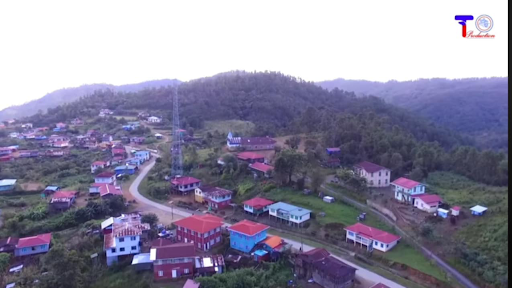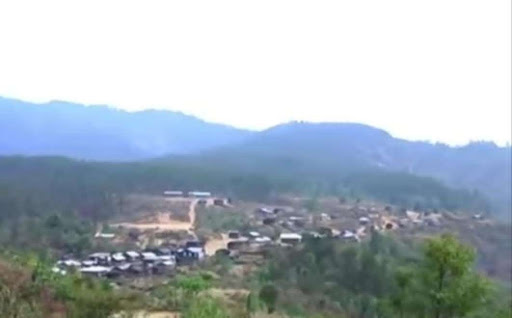NGALANG
History of Ngalang:
The village of Ngalang is located within Zopheiram, Thantlang Township, in Western Myanmar near the border of India. It is situated approximately 52 miles from Thantlang.
Border:
Ngalang is surrounded by several notable areas: Khuabung to the east, Mizoram, India to the west, Zephai to the north, and Lawngtlang and Lungcawite to the south. The total area of Ngalang is approximately 18.5 square miles. According to W.R. Head and H.E. Fisher, the borders of Ngalang are defined by Boklang Mountain (also known as Mangki Lungpum) to the east, Bawinu to the west, Saraw to the north, and Pasuhva (or Pacahva) and Parang to the south.
Inauguration of Ngalang:
Around 1854, chieftain Za Bawi of Vawngtu village sought to establish a new settlement. He entrusted Kivawng and his seven companions with the task of farming and cultivating the land on Lungbing Mountain. However, they began to hear unsettling rumors of the Mar tribe who may have been observing the land for themselves. Faced with the uncertainty of potential conflict, Kivawng and his companions decided to return to Vawngtu village after two years.
Around 1857, chieftain Za Bawi of Vawngtu village entrusted Thang Pum, a member of the Khuplian clan, along with Thang Rung, Ki Vawng, Ni Thawng, Kil Hnin, and Di Hmung of the Lalhnin clan, and five other companions (11 households in total) to resettle in the land of Tlaicin. Mr. Thang Rung served as the village chief for 5 years. Upon Mr. Rung’s passing, Mr. Thang Pum assumed the role of village chief.
Son of Za Bawi, Ral Dun, had three sons: Khua Kung, Chum Mang, and Hlei Lian. Ral Dun designated Tlaicin (Ngalang) to be owned by Hlei Lian. Hlei Lian enjoyed hunting, and the people of Tlaicin joined him on hunting excursions. During one such hunt, Hlei Lian caught two reindeer and to commemorate this event, the villagers celebrated with buffalo meat. While celebrating, Hlei Lian spotted a shoal of fish in the Bawinu River. He pointed out that the villagers could see fish from their village and suggested renaming Tlaicin to “Ngalang”. Around 1910, the name Tlaicin was officially changed to “Ngalang”.
To date, in 2024, the village of Ngalang retains a population of 491, comprising 231 males and 260 females across 97 households. The Ngalang village is located on top of a hill. Due to the hillocks and valleys around the area, it is challenging to inhabit. The village has three churches: Baptist Church, United Pentecostal Church, and Believer Church. Geographically, Ngalang is bordered by the Bawinu River to the west, the Theiruava and Sarawva Rivers to the north, the Vawngkho River, Pasuhva (or Pacahva) and Parang to the south. The residents engage and partake in farming and cultivating for their livelihoods. They owned 17 paddy fields, which allowed them to grow and maintain sustainability.
Christianity:
R.A. Lorrian and his wife, Louise Lorrian, from England, arrived in Serkawr (Tlosai, Mizoram, India) on September 26, 1907, to carry out missionary work for the Lahkher Pioneer Mission in Mara Township. Missionaries Khua Hnok (from Siata, India) and Hup Nawn (from Cakhan, India) later preached the gospel in Ngalang, leading many to convert to Christianity. The village of Ngalang eventually became a Christian village on March 15, 1930.
Missionary:
On May 18, 1936, R.A. Lorrian established a missionary school in Ngalang. Mr. Dar Chum, also from Siata, served as a teacher, earning a salary of Rs. 4 per month, in addition to receiving a bag of rice from each household in the village.
On May 24, 1938, Hakha Siangbawi learned of Tlosia Siangbawi's efforts to establish a mission school and conducted missionary work in Ngalang. He decided to get in contact with Tlosia in the Pangko Valley near Ngaiphaipi village. During their meeting, they concluded several agreements:
1. The Lakher Pioneer Mission will carry out missionary work from the Bawinu River border to the Lusei area. The American Baptist Mission will handle missionary work in the Lairam region.
2. The missionary school in Ngalang will be disbanded.
3. Preachers will no longer be assigned in Ngalang.
4. The missionary work of the Lakher Pioneer Mission will cease.
The people who came from Hakha to attend the meeting were:
- Mr. Naylor (Zipeng)
- Rev. Dr. Joseph Hertbert Cope
- Rev. Dr. Chester U. Strait
The people who came from Tlosai (Lakher Pioneer Mission) were:
- Rev. R.A Lorrian
- Rev. A.B Lorrian Foxall
- Rev. K. Heisa
- Rev. E. Leito
After concluding their meeting in the evening, they enjoyed tea together before departing their separate ways. Lorrian and his friends crossed the Bawinu River to return to Tlosia, while Cope and Naylor made their way back to Ngaiphaipi, arriving in Hakha on May 31, 1938. Unfortunately, Cope Siangbawi fell ill with diarrhea on the return journey and passed away on Saturday, June 11, 1938, at 5:00 AM.






